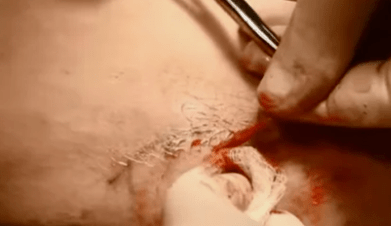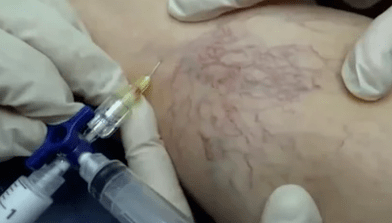Varicose veins or varicose veins, these expressions in phlebology refer to a pathology involving changes, i.e. deformation of the veins.The blood vessels that carry blood to the heart expand and lengthen, their walls become thinner, and the function of the venous valves is disrupted.
If the first stage of varicose veins is treated very effectively with conservative methods, the progression of the disease to the 2nd and 3rd stages can only be cured by surgery;drugs and other methods can only stop the progression of the pathology.This article discusses the main surgical methods of treating varicose veins, the features of their implementation, and so on.
Indications for surgery

Considering the fact that in the first stage of the development of varicose veins, surgical intervention is extremely rarely performed due to lack of necessity, the indication for surgery is a very important factor.The decision is made by the patient together with the doctor based on the data obtained during the detailed vascular diagnosis.
The phlebologist is obliged to talk about the risks of the planned operation, the duration and nuances of rehabilitation after the operation, which are then carried out only with the patient's consent.
As for the indications themselves, varicose vein surgery is required in the following cases:
- Pathological expansion and subsequent deformation of purely saphenous veins is the second degree of severity and higher.
- Extensive forms of varicose veins, the disease affects not only the subcutaneous, but primarily the deep veins, or the deformation of the blood vessels extends to a too large area of the lower limbs.
- There is a severe circulatory disorder, which is also accompanied by deterioration of the blood.
- Severe forms of swelling, high intensity pain, accompanied by pronounced external (aesthetic) signs of varicose veins.
- The formation of trophic ulcers on the skin or subcutaneous hematomas due to disruption of the integrity of blood vessels;
- The progress of the pathological process until the blockage of the venous vessels and the development of the acute form of thrombophlebitis.
- The lack of positive dynamics during conservative treatment, that is, when drugs and other methods of combating varicose veins are powerless.
Limitations and contraindications of surgery
Unfortunately, even if serious forms of varicose veins develop, accompanied by complications and a severe clinical picture, the patient cannot always be referred for surgery.
There are several contraindications that, even if they do not completely exclude the possibility of surgical intervention, still force a person to postpone the operation for a certain time:
- Coronary artery disease - in this case, a more comprehensive examination should be carried out.
- The same applies to stage 3 hypertension.
- Active infectious and inflammatory processes in the body - before the operation for the treatment of varicose veins, the infection must be dealt with or the inflammation must be eliminated.
- 2nd and 3rd trimester of pregnancy - for pregnant women, it is better to postpone any surgical intervention until the woman gives birth.The only exceptions are cases where the life of the mother or the child is in serious danger and surgery can help.
- Skin diseases in the field of operations to combat varicose veins.We talk about eczema, various forms of dermatosis, etc.
- There are also certain age limits, of course for older people.In some cases, advanced age and related senile diseases increase the risk of developing postoperative complications or endanger the life of the person sitting on the operating table.
Methods of surgical intervention for varicose veins
However, if the doctor, based on the diagnosis and examination of the patient, is sure that surgical intervention is necessary, then only the most suitable and effective method must be selected, depending on the degree of progression of the varicose veins and many other factors.To understand what operations there are and in what cases they are performed, we will consider the most effective methods of surgical treatment of varicose veins.
Combined phlebectomy

A full operation that takes place under general anesthesia and can last up to 2 hours depending on the complexity of the task.Phlebectomy can be used to treat the initial forms of varicose veins, but more often this method is used in advanced cases, when the disease has progressed severely.
During the operation, the surgeon makes an incision of up to 2 centimeters in length if the operation is performed in the ankle area, or up to 5 centimeters in a larger area, such as the groin.These incisions are often shallow because they mainly remove the superficial veins.
The principle of the operation is to ligate the anastomosis of the vein and then remove the part of the vein affected by the varicose vein.In addition, during surgery, the surgeon can correct the venous valves to restore normal blood flow.
At the end of the operation, cosmetic stitches are placed on the incisions, a bandage is made, and an elastic bandage is placed on the surgical area to prevent bleeding.
Miniphlebectomy
During the procedure, the affected area of the vein is also cut out, but the size of the operation is smaller and can be considered purely cosmetic.The idea is that the doctor makes a small puncture in the skin, through which he pulls out the part of the vein that needs to be cut out.This surgery is mainly performed on small blood vessels and its advantages include painlessness (due to local anesthesia) and a minimal recovery period.
Sclerotherapy
A relatively new technique, a minimally invasive method, famous for its effectiveness, as well as painlessness due to the same local anesthesia and a practically non-existent rehabilitation period.

The procedure involves the introduction of a special substance into the lumen of the vein - a foaming sclerosing agent.This material causes the walls of the vessel to collapse with subsequent gluing.As a result, the vein does not participate in the blood circulation process, it gradually dissolves and is replaced by connective tissue.
The sclerotherapy technique is primarily used to eliminate small superficial blood vessels and to remove so-called "spider veins".
Laser coagulation
The most modern and, according to many experts, the most effective way to fight varicose veins.Its essence lies in the insertion of a laser light guide into the venous lumen through a hole of only 2 millimeters.When the latter is activated, it starts emitting laser waves, the temperature inside the vein rises, and as the laser is removed, the walls of the vein collapse and stick together.After that, the blood vessel disappears on its own and is replaced by connective tissue.
Of course, the main advantage of this procedure is the almost complete absence of visible damage to the skin, as well as the absence of the need for a rehabilitation period.
Possible consequences
Even the most gentle operation leaves certain traces and can have consequences.First of all, this is due to the fact that an anatomical component of the body is removed - a full-fledged vessel.Of course, with combined phlebectomy, such consequences can be much more serious than a few bruises after laser coagulation.
Consider the most basic consequences that regularly arise after one or another type of surgical treatment:
- When eliminating varicose veins with minimally invasive methods that exclude the removal of the vessel, there is a risk of relapse.This risk is minimal during laser coagulation, only 5%.
- Burns – they occur after operations during which thermal effects were applied.
- Bleeding - can start after any type of procedure, but is more likely after phlebectomy.
- Cases of nerve damage are also known, but this factor is solely related to the level of professionalism of the surgeon.
Rehabilitation process
Rehabilitation, i.e. recovery after surgery, is necessary in all described cases, but if this process lasts only a few days after blood coagulation, it can take several weeks after combined phlebectomy.For a smooth and quick recovery, it is important to follow simple recommendations:
- Follow all your doctor's advice strictly.
- Wear compression garments or elastic bandages.
- If there were incisions, it is important to wait for them to heal.
- After the incisions have healed, it is important to resume physical activity;exercise therapy and regular walks help with this.
- If your doctor prescribes any medication, take it as directed.
- It is useful to visit a massage therapist even after surgery and to prevent the development of varicose veins.
- Do not expose yourself to serious physical exertion for at least 2-3 months.
If the operation went well and the patient fully followed all the doctor's instructions regarding recovery, the probability of a favorable outcome is very high.In most cases, varicose veins can be cured, but this does not mean that the disease cannot affect other blood vessels.For this reason, the prevention of varicose veins should always be carried out if there have been cases of the development of this pathology.























